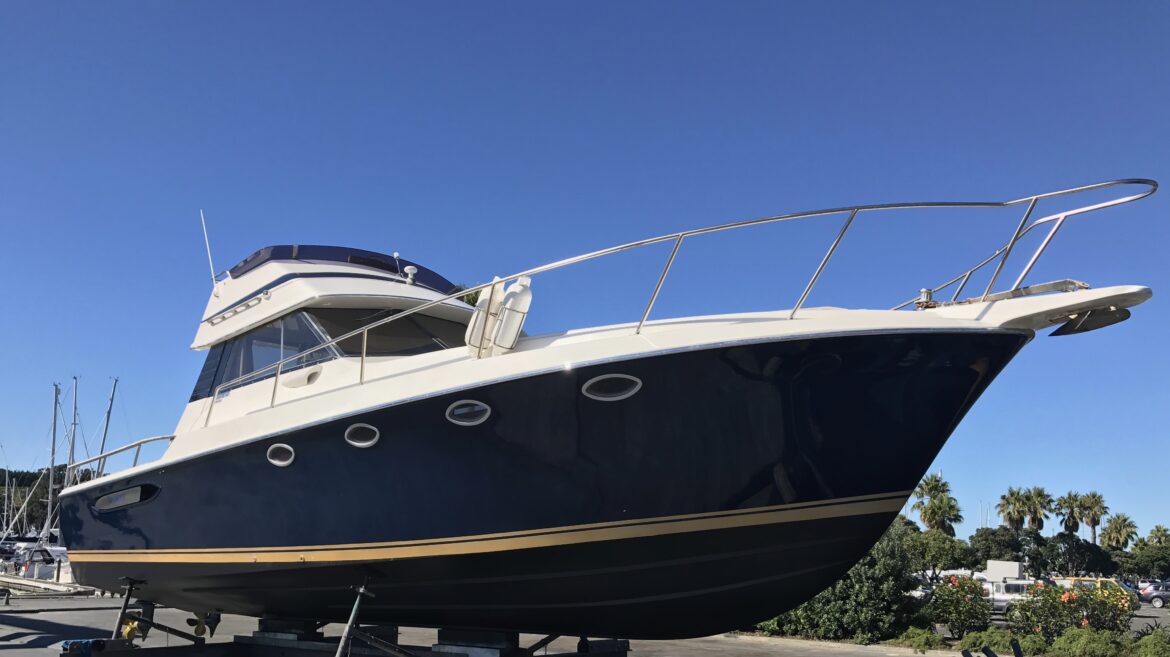As winter approaches, while most boat owners aren’t using their boats as much as in the height of the summer, it is the perfect time to get to grips with maintenance – and maintenance doesn't come more important than keeping your bottom clean.
New Zealand and Australian boaties are understandably proud of their magnificent coastal and inland waterways, but it’s important we all do our bit to make sure our playgrounds don’t become infested with invasive marine pests. The key way to achieve this is by hauling your boat out of the water if it spends a significant amount of time moored. Haul it out and give its bottom a good clean and recoat with a quality antifoul.

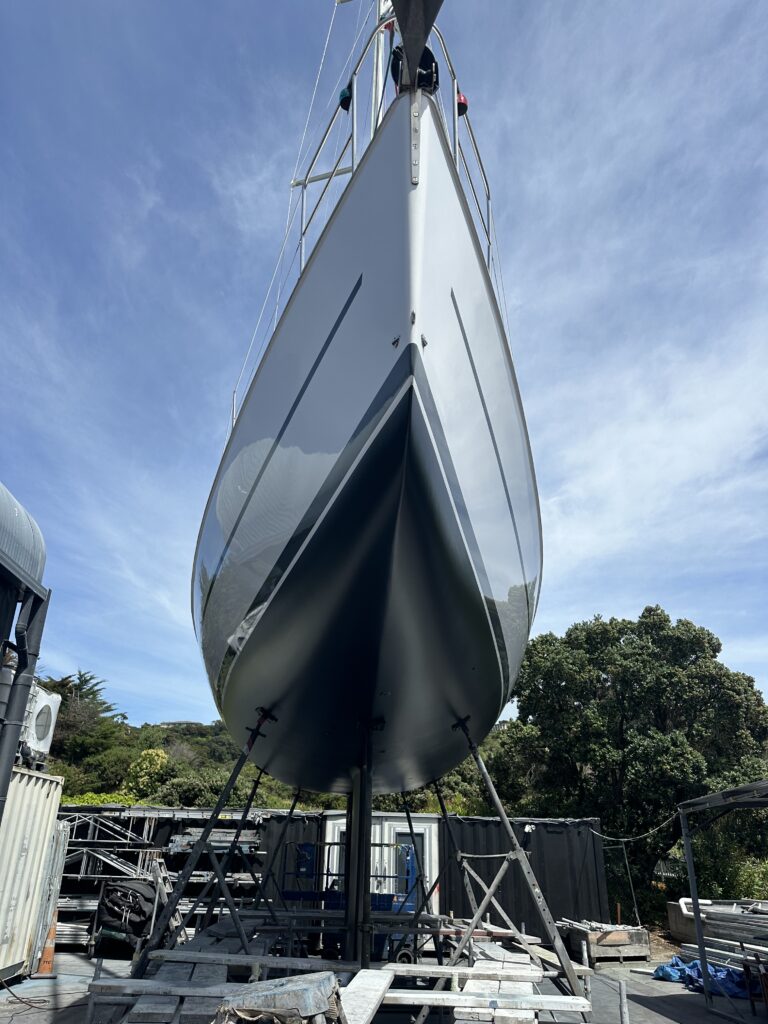
Why do you need antifouling?
Antifouling, as its name suggests, inhibits fouling of the boat – that is, all those hitchhiking pests such as barnacles, slime and weed which attach to the bottom of the boat. As well as helping to keep these pests out of the food chain, antifouling also inhibits them from causing damage to the hull, therefore reducing its speed through the water, and affecting fuel economy. Traditional antifouling paint does this by slowly releasing biocides which hinder the growth, or repel underwater life. Most antifouling contains copper compounds.
Types of antifouling:
Antifouling coatings should be suitable not just for the type of hull you have but also for the way in which you use the boat. Most, but not all copper based antifouling should not be used on an aluminium boat. Choose the right paint for your hull type and underwater metals as they should be protected by a primer to act as a barrier between copper oxide based antifoulings and metals like aluminum, stainless steel, and bronze in order to prevent electrolysis between dissimilar metals. Antifouling paints can be classified as either hard or soft:
Hard (“contact leaching” type) – Hard antifoulings work by releasing biocide from the surface of the coating to deter fouling organisms. Hard antifoulings don’t really wear, but abrasive material in the water such as silt and sand may lead to a very minor reduction in the film build. Biocide leaching rate reduces over the lifetime of the product. After a few seasons, there may be a residual build-up of product that needs to be removed. If you have a fast boat, or a fast boat that is used very regularly, then hard antifouling is usually the preferred product to choose. Boats moored in fresh water normally use these types as eroding antifoulings are designed to erode in salt water and may not erode sufficiently in fresh water. For those who like to race, hard products are a good option as they can be burnished or wet sanded to a smooth finish prior to racing.
Soft (“eroding” or “ablative” type) – Eroding antifoulings, also known as soft or ablative antifoulings, also work by releasing biocide. There are only a handful of products that only work in salt water, generally all ablative or polishing paints work in fresh, brackish, and salt water. It is a combination of the resin technology and the usage of the boat that wears the paint away. Eroding antifoulings are great for those who prefer a low maintenance option, as generally speaking, there is far less accumulation of old paint on the hull after each season. However, a slow build up can still occur if excessive paint is applied at each application, which eventually needs to be removed, as it may become unstable and lead to problems when new antifouling is applied. Soft antifouling splits into two types: Ablative – erodes unevenly, wears off faster where water flow past surface is greater, so not always suitable for high speed craft which are used frequently as the thickness of the film may be reduced too quickly; can be left out of the water for long periods. Self-polishing and CoPolymer – Within this group of eroding/ablative types, there is sub- groups of products known as self-polishing and copolymer antifoulings. With most polishing paints being co-polymers (two or more polymers being combined), only a few are true self polishing and that depends on the resin technology. These include products such as Intermational’s Micron 99 which is a true self polishing product – where the wear rate is a set rate and it doesn’t matter if the boat is moving or at the dock, giving boaters the benefits of both a polishing and hard antifouling. These types of antifoul are generally used by larger vessel owners who require longer periods between maintenance and anyone after increased all-round performance.
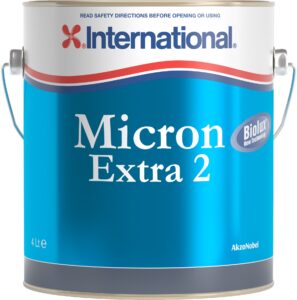
AKZONOBEL – INTERNATIONAL PAINTS
Micron 99 – Micron 99 is a premium true Self Polishing Copolymer (SPC) with Biolux Technology antifouling that provides protection from the harshest hard and soft growth while at the dock and underway. The unique SPC technology helps improve hull efficiencies. For Australian boaters must be on boats over 25 meters.
Micron AP – Advanced performance for difficult fouling in all environments, formulated for use in challenging high fouling areas such as tropical waters and known difficult fouling regions. Incorporates Biolux Technology to help block slime and algae.
Micron Extra 2 – A high strength polishing antifoul with Biolux technology, for even longer lasting protection in most fouling conditions.
Micron One – Ideal for most boaters looking for a fast drying high strength antifouling that wears away with use.
Trilux 33 – A premium antifouling for use on all substrates including aluminum hulls and drives, with added Biolux Technology delivers protection against hard and soft growth in all water types. Available in bright colors, including white.
Ultra 2 – A high-performing hard antifouling with Biolux Technology, ideal for power and sail boats thanks to its smooth, low-friction surface and scrubbable finish.
VC Offshore Hard Racing Antifouling – an antifouling specially formulated for racing, sailing and power boats in salt or fresh water.

ALTEX COATINGS
Altex No. 5 – a multi-season antifoul, containing high levels of cuprous oxide, a self-polishing/ablative mechanism inhibits the attachment of fouling organisms and suitable for moored boats and pleasure boats that require a low maintenance antifoul.
Sea-Zone 60 – a new generation silyl acrylate formulation that protects hulls from marine growth through a self-polishing hydrolysis action. The silyl acrylate, cuprous oxide and co-biocide combination provide outstanding protection.
Pettit Hydrocoat – this is an advanced technology, water-based, ablative antifouling offering multi-season protection against most types of fouling. This technology replaces the harsh solvents found in most bottom paints with water. The ablative surface wears away with use, exposing fresh biocides while eliminating paint build up.
Pettit Vivid – Vivid’s hybrid technology incorporates all the benefits of both ablative and hard paints. Its hard, smooth surface withstands trailering and is easily burnished to a high performance racing finish. Vivid can be used on aluminium hulls and outdrives.
HEMPEL
Olympic 86901 – Hempel’s Olympic is a high solids, tin-free, self-polishing antifoul.
Aluxtra NCT – A premium self-polishing antifouling with Nano Capsule Technology for aluminium vessels, propellers and stern gear. Biocides are contained within the core of the nano capsules which are released when the outer shell of the capsule comes into contact with water and dissolves.
Globic NCT – A premium, copper based self-polishing antifouling with Nano Capsule Technology as above for GRP, steel and wood substrates.
SEA HAWK (A brand of AkzoNobel)
Biocop TF – developed as an alternative to tin-based antifouling paints to protect against the harshest marine environments and provide maximum protection. A new dual-biocide technology and revolutionary polymer binder system “PL3” produces an engineered biocide that leaves no harmful effects on the environment. Biocop TF is considered a top performer among antifouling paints and is safe in salt or fresh water on boats of all sizes.
Cukote – A high loading of cuprous oxide makes this formulation a top performer, even in the most severe fouling areas. As a polishing coating, there is no buildup of bottom paint over time. The hull and underwater surface remains smooth and clean. Cukote copolymer can also withstand removal from water without affecting its antifouling properties.
AF33 – A harder ablative antifoulant, yielding a more durable finish on all types of vessels. AF33 is a popular choice for discerning captains of workboats, daysailers and serious cruising vessels.
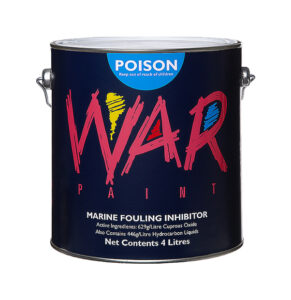
WAR PAINT MARINE ANTIFOUL
A premium Kiwi engineered product by Wet & Forget using modern copolymer resins which contains high levels of cuprous oxide, to fight against a wide range of marine fouling organisms. It has a low ablation rate which allows for all methods of cleaning without significant coating loss. Can be burnished during use to promote speed advantage. Good compatibility over most other antifouls. 16 different colours! Great for racing, cruising, planing or displacement launches.
Compatibility:
If you’re redoing your antifoul for the umpteenth time then you’ll know what type you have used in the past. However, if you’re applying the first coat to a newly acquired second-hand boat or for the first time, then it’s vital to make sure you’re using something which is compatible with what was on the hull before. The first step is to try and establish what the old antifouling is. Do you have the old paint tin lying about? If you are a new owner, can you ask the previous owner what they used for antifouling. If you’re still unsure, wet the boat and rub the hull with your hand to find out whether it’s hard or soft. The old rule of thumb is that you can put soft on hard but not hard on soft. However, the products have now changed and in some brand’s ranges you can put hard on soft. Generally you have three options:-
- Known antifouling: Check for compatibility – there are charts available, or you can check with a professional applicator.
- Unknown antifouling and in good shape: Sand back where necessary and apply a tie coat of sealer.
- Unknown antifouling and in bad shape: Remove old coats of antifouling, prime and then antifoul.
And remember when you’re applying antifouling this time, keep a tin, record or photo handy, so you know what type you used, for the next time you’re redoing the antifoul.

Regulations in New Zealand:
Over the past few years, New Zealand’s Environmental Protection Authority has been introducing new rules about how antifouling paints are produced, used and applied.
The most important changes are that importers and manufacturers must provide more safety info on the cans. Since July 1, 2015, anywhere antifouling is being sanded, scrubbed down or painted must be clearly designated as a Controlled Work Area. Effectively this means having to wear proper protective equipment, display signage that the work is being carried out, and collect and dispose of all waste in accordance with strict regulations. If you’re getting the work done by a pro then they’ll have this all under control, but you won’t be able to dry-sand existing antifouling and if you’re using a spray application then you’ll need proper respiratory gear. Brushes and rollers are still fine.
Many of the rules around antifouling paints changed in 2017, with many now illegal to import or manufacture in New Zealand. The Environmental Protection Authority looked into the rule for all antifouling paints in 2013, including which paints should be sold and used in New Zealand.
After consulting a wide range of people, including the paint and marine industries, commercial and recreational boat users, and other government agencies, they decided to phase out some paints over the following four years. That meant, from June 2017 onwards, antifouling paints containing diuron, octhilinone or ziram could not be imported or manufactured in New Zealand. While these paints were important for New Zealand biosecurity, to inhibit unwanted organisms being introduced and spread by fouled vessels, these paints are slow-release toxic coatings. When numbers of boats are moored together in marinas and harbours, these toxic substances can build up to concentrations that are harmful to people and the marine environment. This ban was on future importing and manufacturing, meaning suppliers and retailers could only sell paints containing diuron, octhilinone or ziram on hand. Disposal of those paints had to be managed carefully, due to the ecotoxic and other hazardous properties of this type of paint.
Antifouling paints must never be dumped in general landfill or sewerage sites, or in the environment on land or in the water. Fast track to August 2023, and new EPA rules came into play, which has been a recent hot topic of many boat owners, suppliers, manufacturers and professional applicators. As of 1 August 2023, the New Zealand Environmental Protection Authority banned the use of antifouling paints containing thiram, diuron, octhilinone and ziram. The EPA said that after reviewing information about the effects and feedback from the public consultation on antifouling paints, it decided the use of some of the paints lead to more risks than benefits.
Even though antifouling paints work by inhibiting the growth of marine plants and animals on boats, helping control marine pests and keeping boats efficient, it also creates risks. The substances can harm marine environments and the people who use the products.
Even though all antifouling paints now supplied and used in New Zealand don’t contain these substances, it has caused boat owners, suppliers, manufacturers and professional applicators to look into alternative methods of antifouling. We look more closely into some of these alternatives.

MACGLIDE
This a product with two uses, for boaties looking for high glide performance and for environmentally friendly antifouling solutions. It is a three-layer polymer self-adhesive film. The principle is based on the low surface tension and smooth finish of the upper layer in contact with the water, reducing considerably any loss of momentum. The combination of adhesive film and silicon layer provide a biocide-free antifouling solution. The antifouling function lasts for the entire maintenance period for the upper layer. The boat begins to clean itself (at a speed of 8 knots) and is easy to clean by hand when the boat is not moving using a soft brush, sponge, window squeegee or soft glove. The advantage of the adhesive film is that it is easy to replace any part of it that is damaged (in the form of a patch available separately).


COPPERCOAT
Coppercoat is not a paint, it is a two-part epoxy coating that prevents fouling for 10 or more years, and also provides hull substrate protection for aluminium, steel, GRP and wooden vessels. Proven on almost 100,000 vessels worldwide, Coppercoat has a very low coefficient of drag and is favoured by racing yachts and powerboat owners seeking improved speed, lower fuel consumption and reduced emissions. Coppercoat is solvent-free, electrolytically inert and classified as non-eroding and non-hazardous {EPA 2023]. It does not discharge ozone depleting VOCs into the atmosphere, nor does it discharge biocides, silicone or plastics into our marine environment. The performance of Coppercoat is unaffected by 2023 EPA Regulations restricting biocides in antifouling paints and it is an International Award Winner for Environmental Responsibility. Any initial cost premium that may exist for Coppercoat compared to multi-layer antifouling alternatives, is typically erased after two years and thereafter, the product delivers significant cost savings year after year. Coppercoat maintenance requirements are minimal, saving thousands of dollars on annual maintenance.

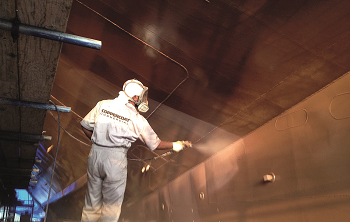
PROPSPEED – RUNNING GEAR PROTECTION
There are a number of specialist coatings, designed to prevent marine growth from bonding to metal surfaces on your running gear. These are usually made up of an etching primer, which bonds to the metal substrate and a clear coat, which provides an ultra-smooth outer layer. It’s so slick that marine growth can’t get a grip on it. Propspeed, the original and we believe, the best performing foul-release coating in the industry, has been tried and tested around the world since 1999 and is a defence against marine growth and corrosion for all underwater metal assets. It provides a strong long- lasting adhesion to metals and protects underwater metal assets for 12-24 months. It is biocide free, being a foul-release coating, not an antifoul, creating a surface that’s tough for marine organisms to adhere to.
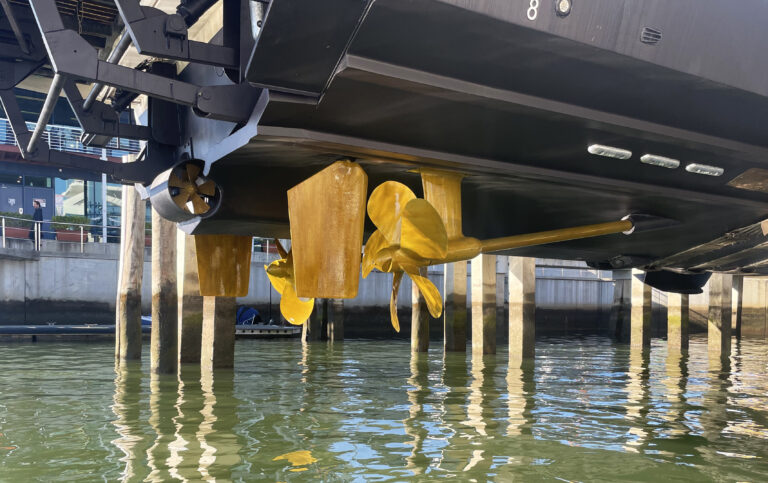
SUMMARY
If you need to antifoul your boat, also be sure to choose an antifouling that fits your schedule and will allow you to launch it within the recommended time frame. Antifoulings have specific time-windows between application and launch and if you miss that window, extra work to reactivate the surface will be required to ensure the antifouling hasn’t sealed off and will release biocides once launched. Finally, remember that painting a boat bottom is a dirty, labour-intensive, difficult job — especially if it has to be stripped first. Unless you really enjoy DIY work, don’t mind getting grimy, and have plenty of time on your hands, this is probably a job you want to leave to the professionals. Properly applied, with good quality antifouling, will still give very good protection for up to two years (and in some cases considerably longer).


